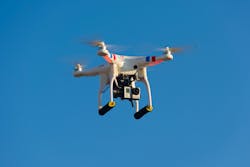Today’s consumers seem to have an undying thirst for immediate satisfaction. This is true whether it is an experience, media content or even packages. To quench this thirst, a growing number of companies have boosted the cost-effective availability of same day and next day delivery options. However, the rise in must have deliveries has created new levels of congestion, especially within cities like New York where carriers deliver over 1.5 million packages per day.
Fortunately, today’s evolving technologies offer some relief. For instance, as connected cars become the norm, the smart grids will result in better visibility to roads, meaning couriers can better manage their routes and lessen congestion. Drones also offer hope by lowering courier road use, especially for smaller packages. There are a few trials underway. For instance, UPS worked with CVS to deliver prescription drugs to customer doorsteps via its drone delivery program.
Digging deeper
According to Taqee Khaled, director of strategy at Nerdery, the most natural extension is in the transport of medical technology-related items. “There is certainly a captive market among certified lab testing where equipment is a daily need, highly predictable and can be high margin for reagents and biological agents,” he says. “Taking it a step further, within lab results, certain high-risk and high-value testing laboratories might be naturally incented to want rapid, low-friction custom delivery from drones, like oncology, infectious disease, etc.”
Khaled tells IndustryWeek, as more organizations embrace drone technology it will understandably have an impact on how manufacturers view the supply chain. “Drones will immediately raise data points around optimal weights, densities, package dimensions and distances traveled that will need to be sorted and prioritized against customer need frequency and margin for parts shipped,” he says. “If you are an original equipment manufacturer, you're going to want to identify the lightest weight and highest margin items that are most often needed by your B2B customers. This might not always exist, so you may have to go down the list to the next best option, which would be the incentivization of such purchases with ancillary bundling, like Walgreens is doing with their OTC drone bundles in Virginia.”
Addressing challenges
Understandably, leveraging drones has its own set of challenges. In some ways this is not dissimilar to the increasingly common phenomenon of receiving random packages on your door stop, explains Khaled. “It turns out that social sea change has done a lot to lower the 'weirdness' bar for drones. Consumers might not care if their smaller packages gently flew onto their doorstep without a human footprint."
In fact, if they're told it lowers their carbon impact, they might be more inclined,” he says. “If it means zero interaction with a person, they might be even more enticed. Where it gets dicey is in highly private drops like prescription drugs. There is the duality of a theft issue and proving receipt for potential insurance reimbursement, combined with the potential of social stigma if very small packaging is routinely dropped in visibility of your neighbors — think of it as a public viewing of your personal medicine cabinet.”
About the Author
Peter Fretty
Technology Editor
As a highly experienced journalist, Peter Fretty regularly covers advances in manufacturing, information technology, and software. He has written thousands of feature articles, cover stories, and white papers for an assortment of trade journals, business publications, and consumer magazines.
